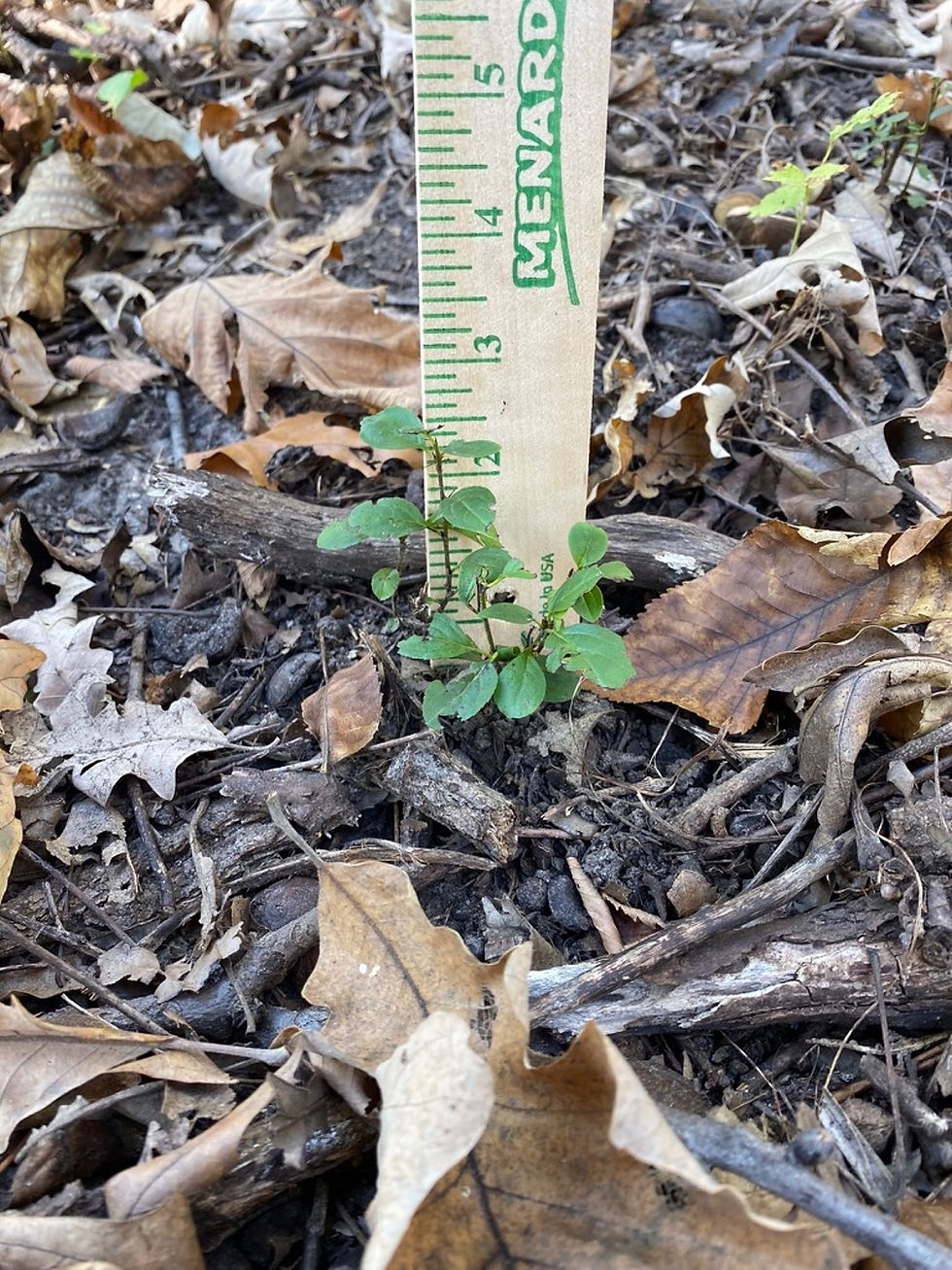Eliminating Buckthorn by Repeatedly Cutting Without the Use of Herbicide
- jonathanrigden
- Jun 23, 2023
- 4 min read
Buckthorn is an invasive shrub that has infested many of the forests and bluff prairies of the Upper Midwest, including Hixon Forest in La Crosse. It is known that cutting buckthorn without treating the stump with an herbicide causes it to resprout, often with multiple stems. It is not well known how frequent and for how long buckthorn must be cut for it not to resprout. Friends of the Blufflands and the Coulee Region Chapter of The Prairie Enthusiasts sought to help answer this question by sectioning off an area in Hixon Forest with heavy growth of relatively small buckthorn plants and cutting parts of that area at different frequencies from mid-June 2022 until the first hard frost or a temperature of less than 28 degrees Fahrenheit. We hope to be able to determine the minimal frequency that young buckthorn needs to be cut after mid-June as a way to eliminate it without the use of herbicides.
Hypothesis- If young buckthorn is repeatedly cut it will eventually not resprout. The minimal frequency after mid-June until the first hard frost at which this cutting must take place is unknown.
Methods- A 10 x 40 feet plot chosen for its uniformity of buckthorn growth will be marked off and divided into four sections each measuring 10 x 10 feet. These sections will be arranged such that they go up the slope from bottom to top and will be cut as close to the ground as possible at four different frequencies- every 2 weeks, 4 weeks, 6 weeks and 8 weeks until the first hard frost. A border will also be cut around this 10 X 40 foot plot. The nearby uncut buckthorn will be used as a control. The first cutting of the entire plot will take place on June 16 with a brush cutter with a blade. This date was chosen because it was thought that much of the energy from the roots will have been invested into plant and leaf growth by that time with relatively little regeneration of the root energy from photosynthesis. Subsequent cuttings will be done from that date. It is recognized that new seedlings from the seed bank will appear and have to be taken into consideration.
On 6/16/2022 a 15 x 50 feet section on Lookout savanna, well east an area that had been foliar sprayed the previous year and easily accessible from Savanna Trail in Hixon Forest, was chosen for its uniform growth of common buckthorn. The buckthorn was about waist to shoulder tall with the diameter of stems mostly about 0.5 to 0.75 inch or smaller. There were minimal other woody plants present, such as honeysuckle or oriental bittersweet. This area was cut with a weed wacker with a blade close to the ground, the cut stems were gathered and removed from the area, then a second pass was made with the weed wacker to assure that all the stems were cut. Then four side-by-side 10 x 10 feet areas were staked out within this 15 x 50 foot area. Down the slope and separated from the 15 x 50 area by a 3-4 foot cut buffer, a second 10 x 10 area had all the woody plants removed with the traditional cut and treat method using hand held pruners and 20% triclopyr in bark oil with surfactant and blue dye.
Here is a photo of the area before cutting:

Four 10 x 10 feet sections marked off after cutting:

Cutting schedule (though the actual cutting took place near these dates due to weather or other factors):

Study plot 2 weeks later on 6/30:

Typical regrowth of cut buckthorn on 6/30:

Section #1 recut:

The cuttings proceeded through the year according to the schedule with the last cutting of sections 1 and 3 taking place on 10/25/22 after which a hard frost occurred. Here are the measurements of growth in the 4 sections on this date:
Section #1:

Top 5 averaged 1.5 inches of regrowth
Section #2:

Top 5 averaged 2 inches of regrowth.
Section #3:

Top 5 averaged 4 inches of regrowth
Section #4:

Top 5 averaged 5 inches of regrowth.
The 4 sections came through the winter as seen in the following photos taken on 6/6/23:
Section #1:

Section #2:

Section #3:

Section #4:

A view of the entire plot looking east :

Note that some of the stakes fell over during the winter months. Also note that the green seen in the photos is mostly other plants such as violets, not buckthorn, except in section #4. As seen in the photos, sections 1, 2, and 3 were almost identical with some minimal regrowth of buckthorn. Section 4 had significantly more regrowth both in the number and height of the plants.
The separate section that had the buckthorn removed by traditional cut and treat was almost free of buckthorn on 6/6/23 with three plants still present. These were likely either missed or not enough of the herbicide was applied to be effective.
Conclusion:
Repeatedly cutting common buckthorn approximately every 6 weeks starting in mid-June until the first hard frost can be an effective strategy to eliminate most of the buckthorn and be left with very few stems and a much more easily managed population the next year. In this example that meant cutting the area four times from mid June to late October at 6 week intervals. Of note, the cuttings were done very close to the ground such that almost no leaves were left on any of the plants that had regrown. This might be difficult to replicate in a large area.





Thank you for doing this. I have been contemplating the best buckthorn management strategy for the Gateway trail system and this is very interesting.